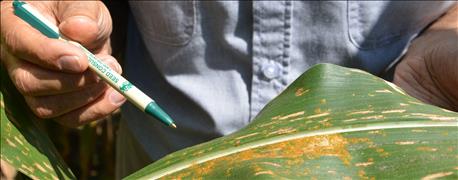
Steve Gauck, who has written the Summer Scouting Report column all season, first noted that he had spotted southern rust on corn leaves around mid-August. He started seeing southern rust in fields south of U.S. 50 in southern Indiana.
Just a few days later, Dave Nanda found a classic example of southern rust in a cornfield in central Indiana. He was walking through the Crop Watch ’16 field.

LATE-SEASON DISEASE: Southern rust was fairly easy for Dave Nanda’s trained eye to pick out while walking the Crop Watch ’16 field in late August. The disease likely came in too late to cause damage.
Gauck is a sales agronomist for Beck’s, working primarily in southern Indiana. Nanda is a crops consultant based in Indianapolis. He works with Seed Consultants Inc., sponsor of Crop Watch ’16. Both note that when leaf diseases, including rust, come in this late in the season, it’s likely they will do little, if any, damage to yields.
Here is a closer look at southern rust and its cousin, common rust. Nanda also believes he saw some common rust in the Crop Watch field. Again, it likely won’t be a yield factor.
The following information comes from the Purdue University Corn and Soybean Field Guide, 2016 edition. The guide is edited by Corey Gerber, Purdue agronomist and director of the Purdue Crop Diagnostic Training and Research Center.
Common rust. It’s more typical to first find this leaf disease in June, according to the Purdue guide. Common rust prefers temperatures from 61 to 77 degrees F.
Most hybrids have resistance that limits the severity of common rust, but inbreds can be susceptible, the guide notes. Since hybrids are typically resistant, treatment isn’t usually needed.
Southern rust. The classic example of southern rust that Nanda found in the Crop Watch field fits exactly with where and when you would expect to find it, according to the Purdue guide. Southern rust typically appears in late July or August, when temperatures are around 77 to 82 degrees. Southern rust likes hotter conditions.
Light brown to orange pustules on upper leaves are typical symptoms of southern rust. According to the Purdue guide, each pustule is originally surrounded by green tissue. However, the tissue turns yellow and then brown as the disease progresses.
Southern rust typically appears too late in the Corn Belt to cause yield damage and warrant treatment, the guide notes. Nanda says that will likely be the case this year, as well.
Neither one of these diseases overwinters in Indiana, according to the Purdue guide. Both ride in on the wind during the growing seasons, carrying the fungi up from where they overwinter in more southern climates.
“Southern rust bears the name of where it comes from, but note that both southern rust and common rust don’t overwinter here,” Nanda says. “Both must be carried into the state on wind currents coming out of the Southern states."
About the Author(s)
You May Also Like




